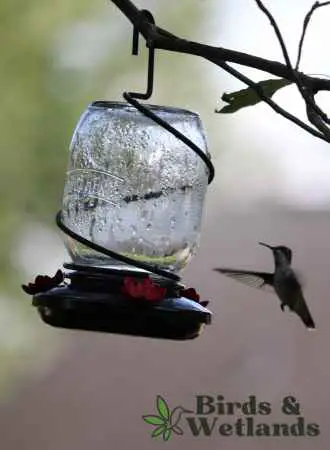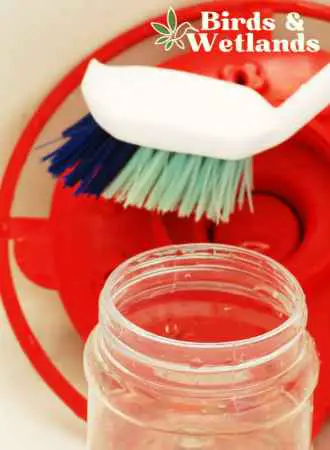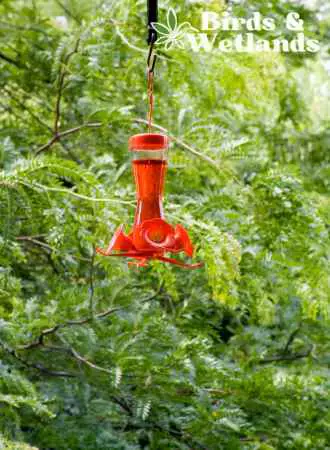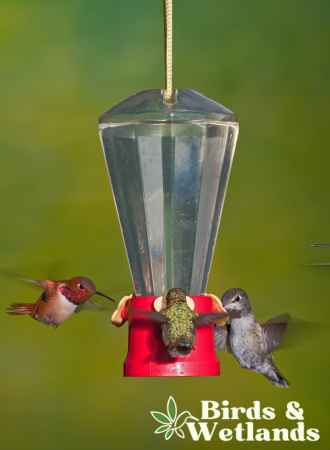Keeping your hummingbird feeders clean not only helps attract more hummingbirds to your yard but also ensures that the birds stay healthy and disease-free.
Vinegar is one of the most effective and eco-friendly ways to clean your hummingbird feeders. Vinegar is a natural cleaning agent that can help remove stubborn stains and residue without harming the birds or the environment.
In this blog post, we’ll go over the steps for cleaning hummingbird feeders with vinegar, as well as some other helpful tips for keeping your feeders clean and in good condition.
Key Takeaways on How to Clean Hummingbird Feeders
- Cleaning your bird feeder regularly prevents mold and bacteria growth, keeps nectar fresh and clean, avoids attracting pests, and keeps birds healthy.
- Vinegar is an effective cleaning solution alternative to bleach solution that you can use to clean your bird feeders.
- Other ways to maintain your hummingbird feeders include placing them in the shade, rotating them and bringing them in at night and using your dishwasher.
Why you should clean hummingbird feeders?

Cleaning hummingbird feeders regularly is crucial for the health and safety of these tiny birds. Here are some reasons why:
Preventing mold and bacteria growth
Hummingbird nectar is a sugary solution that can quickly ferment, promoting mold and bacteria growth. These harmful microorganisms can cause the nectar to spoil, become cloudy, or develop a foul odor.
Consuming spoiled nectar can make hummingbirds sick, leading to diarrhea, dehydration, and other health problems. In severe cases, it can even cause death.
Regardless whether you’re using seed feeders or tube feeders, cleaning the feeder regularly can prevent mold and bacteria buildup, ensuring that the bird food or nectar remains fresh and safe for hummingbirds to consume.
Keeping the feeder clean and fresh

Hummingbirds are attracted to clean, fresh nectar. If the feeder is dirty or has debris, such as dead insects, it may discourage hummingbirds from feeding.
It is important to clean the feeder thoroughly, remove any debris or residue, and replace the nectar with a fresh solution at least once a week, even if it is not empty. Doing so ensures that the feeder is clean, attractive, and appealing to hummingbirds.
Avoiding pests
Dirty feeders can attract unwanted pests, such as ants, wasps, and bees. These insects are not only a nuisance but can also contaminate the nectar and pose a risk to hummingbirds.
Ants, for example, can drown in the nectar, making it unsuitable for hummingbirds to consume. Wasps and bees can aggressively defend the feeder, preventing hummingbirds from feeding and potentially harming them.
To avoid attracting pests, clean the feeder regularly, and hang it in a location that is not easily accessible to insects.
Protecting hummingbird health

Dirty feeders can spread diseases, such as salmonella and fungal infections, that can be fatal to hummingbirds.
Salmonella is a bacteria that can contaminate the nectar and cause salmonellosis in hummingbirds. This infection can lead to lethargy, weakness, and diarrhea and can be fatal if not treated promptly.
Fungal infections, such as aspergillosis, can also be transmitted through dirty feeders, causing respiratory problems and death in hummingbirds.
How to clean a hummingbird feeder with vinegar

Hummingbirds are fascinating creatures to watch, but it’s important to keep their feeders clean to prevent the growth of harmful bacteria and fungi that could harm their health. You’ll know that it’s time to clean your dirty feeder when all the nectar look cloudy or with the presence of floating insects.
One of the best ways to clean a hummingbird feeder is by using vinegar, a natural disinfectant that is safe for the birds and the environment.
Here’s how to clean a hummingbird feeder using vinegar:
Materials:
- vinegar
- very warm water
- bottle brushes or pipe cleaners
- dish soap (optional)
Instructions:
- The first step in cleaning a hummingbird feeder is to take it apart after disposing of old nectar. Remove the lid, the base, bee guards and any other removable parts. Keep track of all the small pieces, so you don’t lose them.
- Fill a large bowl with equal parts warm water and white vinegar. Soak the feeder parts of the hummingbird feeder into the water solution and let them soak for about 30 minutes. This will help dissolve any sugar or nectar residue and kill harmful bacteria or fungi.
- After soaking the parts, use a special bent brush or pipe cleaner to scrub away other debris or buildup from the nectar reservoir. Make sure to scrub all the crevices and hard-to-reach places such as feeding ports, as these are the places where bacteria and fungi can thrive. If needed, you can also use a small amount of soap to help remove any stubborn stains or buildup.
- If your feeders already have molds, you may need to do more thorough cleaning. You can also add rice to the feeder and shake it.
- Properly clean the feeder parts, rinse them thoroughly with warm water. Be sure to rinse off all harmful residue such as bleach residue and soap residue, as these can be harmful to hummingbirds if ingested.
- After rinsing the parts, use a clean cloth or paper towel to dry them off. Make sure all the parts are completely dry before reassembling the feeder.
- Once all the parts are dry, wipe with dry cloth, reassemble the clean feeder. Fill it with fresh store-bought nectar and hang it in a shaded area away from direct sunlight. Remember to clean the feeder every few days to prevent the growth of harmful bacteria and fungi.
Additional hummingbird feeder care tips
Here are additional tips on looking after your nectar feeders:
Place hummingbird feeders in the shade

Feeding hummingbirds is one of the most joyful experiences backyard birders can have in their backyard. But these small birds prefer to feed in cool and shady areas, as direct sunlight during hot weather can cause the nectar to spoil and ferment quickly. Placing the feeder in the shade even in cooler weather helps to maintain the quality of the nectar, ensuring that it remains fresh and appealing to the birds.
Additionally, mold growth slows significantly and the hummingbird food doesn’t go back as quickly.
Hanging several feeders in the shade can also help to reduce the risk of overheating, which can cause dehydration and discomfort in the birds.
Hummingbird feeders in the shade create a natural and welcoming environment for hummingbirds, encouraging them to visit your feeder regularly.
Rotate hummingbird feeders
Hummingbird feeders need to be properly maintained to ensure the health and well-being of these beloved avian species. One way to do this is by rotating the feeders in the morning to prevent sugar water from fermenting in the hot sun, which can harm hummingbirds.
Additionally, bringing the feeders in at night can also prevent fermentation and deter nocturnal feeding by insects or animals.
Hummingbirds rely heavily on nectar as their primary food source, so providing fresh, clean nectar is essential for sustaining their population.
Rotating the feeders also prevents aggressive behavior among hummingbirds, as they will not become territorial over one specific feeder.
Use smaller hummingbird feeders

One of the biggest problems with using larger feeders is the amount of nectar they hold. While more liquid seems like a good thing at first, more nectar is wasted, especially if there aren’t many hummingbirds in your area.
Hummingbirds are known to be picky and prefer fresh nectar over stale nectar, which means that if your feeder isn’t being emptied regularly, the nectar might go to waste.
Using smaller feeders can help alleviate this problem. By using a smaller feeder, you can ensure that the nectar is being consumed before it has a chance to go stale.
Additionally, smaller feeders can be easier to clean and refill, which can help you maintain a consistent supply of fresh nectar for your feathered friends.
Another benefit of using smaller feeders is that they can be placed in more locations around your yard. Because they are smaller and lighter, you can hang them from more delicate branches and positions, attracting hummingbirds to new areas of your yard that might not have been accessible with larger feeders.
Of course, using smaller feeders doesn’t mean that you have to sacrifice the amount of nectar you provide to your hummingbirds. Instead of using one large feeder, you can use multiple smaller feeders to spread out the nectar supply. This can also help reduce competition between hummingbirds, as it can be challenging for multiple birds to access a single feeder.
Use a dishwasher
If you’re looking for an easy way to clean your hummingbird feeder, using the dishwasher might be a great option for you. However, before you pop your feeder into the dishwasher, make sure it’s dishwasher-safe by checking the manufacturer’s instructions.
Assuming your feeder is dishwasher-safe, it’s important to remove any leftover nectar and rinse it thoroughly with hot water. Then, place the feeder in the top rack of your dishwasher and run it through a normal cycle without any detergent or other dishes.
While your feeder is getting a good cleaning in the dishwasher, make sure you have more feeders available for the hummingbirds to continue feeding. You don’t want to leave them without a source of food while their favorite feeder is being cleaned.
Once the dishwasher cycle is complete, remove the feeder and inspect it to make sure it’s completely clean. If any residue remains, wash it by hand using a bottle brush and hot, soapy water. Rinse it thoroughly with cold water and allow it to air dry completely before refilling it with new nectar and hanging it back up outside.


